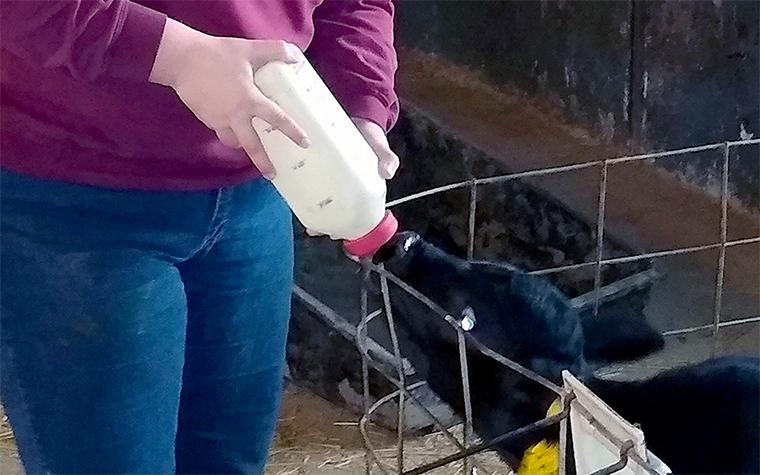COLUMBIA, Mo. – Colostrum, the first milk produced by a cow’s mammary glands after giving birth, is liquid gold for baby calves.
The thick, nutrient-rich fluid provides essential nourishment and crucial immunity in the form of antibodies to newborn calves in the first 24 hours of life. It also is the first line of defense that jump starts the calf’s undeveloped immune system and provides it with critical protection for calf health and survival.
University of Missouri Extension state dairy specialists Scott Poock and Stacey Hamilton are part of MU’s Foremost Dairy Farm team near Columbia where calving occurs year-round. But most of the calving occurs in fall.
They know that colostrum is vital to cow health – and the checkbook. “Besides doing what is right for the welfare of the animal, the loss of an $800 calf or a future lactating cow and her productivity can be impacting cashflow and the checkbook,” says Poock.
Poock, a veterinarian, says colostrum is rich in immunoglobulins (IgG), antibodies that protect the newborn from bacteria, viruses and other pathogens until the calf’s own immune system matures. Along with the IgG antibody, colostrum is rich in fat, protein, calcium and vitamins A and E to give the calf a boost.
Poock and Hamilton remind dairy producers of 5Qs of colostrum management:
1. Quickly feed colostrum. Quick-feed as soon as possible after birth to maximize antibody absorption – no longer than six hours after birth. Ideally, feed 1-2 hours after birth. Follow with a second feeding 12 hours later. “Remember, the clock is ticking as absorption rate of antibodies is roughly 30% of the original absorption rate capacity by 12 hours post-birth, while the gut is essentially closed to large antibody molecules after 24 hours,” says Poock.
2. Quantity. Feed about 10% of the calf’s body weight in the first 12 hours (e.g., about 4 quarts for an 88-pound calf). Typically, the initial feeding is 4 quarts. Some farms follow this up with another 2 quarts in 8-12 hours.
2. Quality. High antibody concentration from healthy, well-fed cows (older cows often produce better colostrum). Use a Brix refractometer to measure fresh colostrum (should be greater than 22% on the Brix scale) or a colostrometer that measures the specific gravity. A reading > 22% Brix or green zone on the colostrometer correlates to at least 50 grams of IgG per liter. Feed this high-quality colostrum to the calf first.
3. sQueaky clean. Harvest the colostrum with the utmost cleanliness into disinfected equipment. Then cool/freeze quickly. Dirty colostrum can reduce the absorption of the antibodies in colostrum, says Hamilton.
4. Quantifiable. The most useful way to quantify your colostrum management is to assess total proteins on calves 1-7 days of age.
A new spreadsheet available from Mizzou can evaluate your colostrum management. More than 40% of calves should have a total protein of > 6.2 g/dL and less than 10% of calves with a total protein of < 5.1. Mizzou’s Foremost Dairy exceeds these goals by have 57% of calves > 6.2 and only 1.5% of calves < 5.1 g/dL.
If you are interested in using the spreadsheet to evaluate your farm, contact Scott Poock at poocks@missouri.edu.
